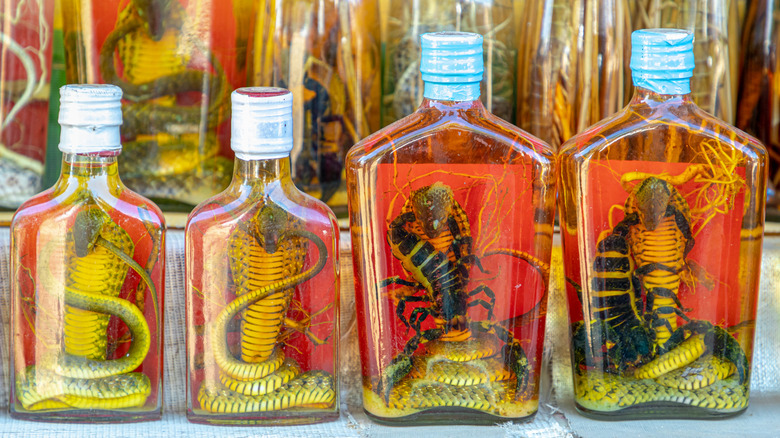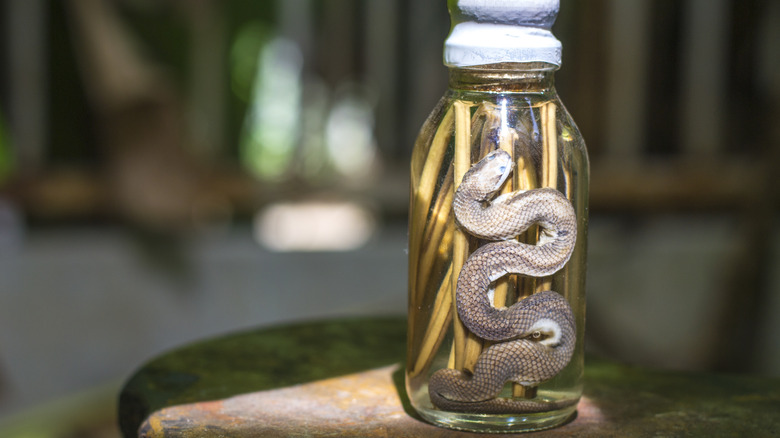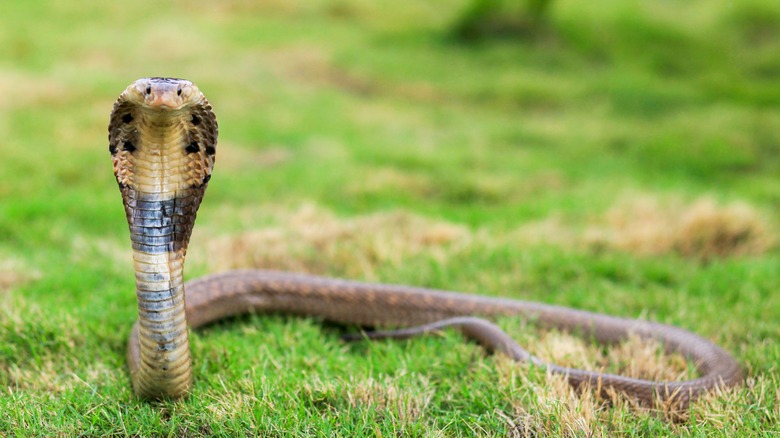Snake-Infused Whiskey Is Just As Daunting As It Sounds
While it might be cool to try the most expensive whiskey in the world, trying a snake-infused whiskey takes it to a whole new level. Snake-infused alcoholic drinks were first recorded in China as early as 771 B.C., with some cultures believing the combo to have healing properties. Today, various snake-infused drinks are still enjoyed in a number of Southeast Asian countries, with another version of snake liquor simultaneously persisting in Peru.
Regardless of location or spirit used, most are made the same way, beginning with trapping a live snake into a bottle of rice wine, rum, whiskey, etc. The snake is sacrificed for the process and its remains ferment in the alcohol for a minimum of two months, ideally up to six months for maximum potency.
On its own, the drink has a strong, bitter taste that doesn't exactly let you forget about the dead snake soaking in it. For added flavor, some producers include spices and herbs, while others include extra organisms like scorpions, geckos, or insects. Between the drinks' deadly appearance and inclusion of literal snake venom, it's no wonder so many cultures view its consumption as a show of bravery.
The alleged healing properties of snake-infused whiskey
Although the specific uses of snake-infused whiskey may have varied from one culture to the next over the centuries, one thing remains constant: the belief that the drink possesses healing properties. Some folklore traditions, for instance, say that snake-infused whiskey could act as a pain reliever or even an aphrodisiac. Meanwhile, other Southeast Asian cultures have believed that the drink could help with ailments like hair loss, arthritis, and dry skin.
Of course, we can't talk about the supposed benefits of drinking snake-infused whiskey without touching on the potential dangers. The drink is generally considered safe, with experts saying the snake venom is neutralized or broken down by the alcohol. Instead, the biggest dangers are more or less the same as overdoing it with any other kind of alcoholic beverage — confusion, loss of consciousness, vomiting, seizures, and even trouble breathing, per the NIAAA. As such, snake-infused drinks are actually banned in some countries.
Environmental concerns to consider with this type of alcohol
While the health risks associated with drinking snake-infused alcoholic beverages are enough to make some people take pause, the impact on the environment are likely to turn off others. The primary issue with snake-infused alcohol production is that, while some snakes may be farmed, many of the snake species used are wild-caught and endangered. Alcohols using cobras, for example, are illegal in the U.S. for this exact reason. Other countries have banned snake-infused beverages on the premise that drowning the reptile in alcohol or even just removing its venom constitutes animal abuse.
Similarly, the use of snakes in beverage-making has led to over-hunting of desirable species, and, in turn, has upset fragile ecosystems. Particularly in Vietnam, a decrease in snake populations has resulted in increased rat populations. The rats then destroy valuable crops that would have otherwise been protected by snakes. Truly, producing and consuming this bizarre drink isn't as straightforward as you might think.



